
by ARTHUR BOYNTON
Since the July 1964 issue of AUDIO Magazine, I have been trying to realize excellent stereo performance from FM tuners. The article published by Mr. Daniel R. von Recklinghausen in the August 1963 issue of AUDIO pointed me in the right direction. He made it clear how important it was to obtain a linear phase-shift in the FM i.f. pass band. As my article hints, the linear phase-shift concept can be approached by using a sweep generator, and being careful! What was not emphasized was the care required in other areas, alignment of the r.f. section, alignment of the stereo decoder section and accurate alignment of the i.f. section.
IT HAD BEEN ASSUMED that most technicians understood r.f. alignment, as I had found this technique to be widely practiced by electronics technicians during my tour of duty with the U.S. Navy.
The real challenge was trying to solve the riddles of achieving excellent performance from the stereo decoders, (multiplex portion of stereo tuners, or separate multiplex adaptors). This challenge started when I had the opportunity to examine and adjust various Heathkit, EICO, Scott, and Harman-Kardon units belonging to friends. In spite of the remarkable improvement that I was able to coax from each of these tuners, my desires were never fully satisfied. The purchase of a Scott multiplex adaptor for my Scott C330 AM-FM tuner did open up a new era of listening pleasure for me. But even here, I could not recapture what I felt to be a truly adequate representation of the broadcast signal. This purchase also introduced me to a new twist in tuner alignment.
The Scott people recommended using a 100-percent, 400-Hz, frequency-modulated r.f. carrier to align their tuners. This I could not do with my sweep generator.
Thus the need was felt to obtain a stereo generator. As I enjoy building kits, a Heathkit unit was chosen. Was I ever disappointed when I discovered that my particular needs exceeded the quality level of this popularly priced unit! Since a quality alignment job requires an accurate source of stereo signals, this section will be devoted to those steps I went through to improve my Heathkit Stereo Generator-beyond all expectation! The discussion in Part 2 shows you how I use my equipment to best advantage. And you can do likewise.
As the unit stood, there was no way for me to improve upon the adjustments of my Scott tuner system. Since Scott uses the technique of measuring residual distortion for part of the adjustments, the signal-to-noise ratio of the generator must be good. The hum, noise, and distortion must be somewhat lower than the minimum values to be expected from the best stereo tuners. Another operation requires an accurate left and right signal, with crosstalk lower than the capability of the tuner to resolve the signal.
For a reading of 1 percent, the total hum, noise, and distortion must be down 40 dB. So my attention was turned to the stereo generator to improve the quality of its signal.
Getting Rid of the Hum
Hum was the first order of business. The goal was to have the hum low enough so that it would provide a reading of no more than 0.5 per cent when using the residual distortion measuring technique. (The signal was monitored at the Composite Signal/Audio jack for all of the measurements.) So the single diode rectifier was replaced with a full-wave bridge. The ripple was reduced, mostly because the frequency was doubled. The hum persisted. Shielding of V5 prevented any excess 60-Hz pickup when my hand was near, but there was still hum! The power line to the switch was next shielded as these wires are strung through the audio area. While the hum was reduced a little more, it was still annoying.
Poking around the filter coils (L5, L6, and L7) showed me that the hum was getting in through them! The magnetic field of the transformer was inducing a 60-Hz field into the coils, in spite of a copper strap around the transformer, and proper transformer orientation! An attempt at shielding the coils by wrapping them in tape and then aluminum foil and tape again was tried. This had no effect against magnetic fields, only electrostatic fields. While no improvement was obtained, the shields were never removed.
Reversal of the connections to coil L7 reduced the hum by making the induced voltages in L5 and L6 oppose the induced voltage in L7. See Figs. 1 and 3. This was a tremendous improvement, but its discovery didn't stop my relentless search.
By changing the filament string to twisted pair, and providing an above chassis ground return for V5, the hum was almost licked. Balancing of the filament string to ground through a pot, or biasing it to +30 volts made no further improvement, so these items were not included in the final fix. Providing an extra B + decoupling filter for V5-A finally reduced the hum to 52 dB below full output. (Reference is 0.4 volts rms at the Composite/Audio output jack, which is equivalent to 0.86 volts rms at the external input jack, which comes next.)
Now the distortion needed working on. The internal audio generator just didn't have it. So a phone jack was installed just below the audio output for an external audio input. It is wired so as to disconnect the internal signal whenever a phone plug is pushed in. See Fig. 3 and 10.
The Audio Generator
At this point, it must be mentioned that my Heathkit AG-9A audio generator was modified to obtain lower hum and improved distortion and frequency response of the 1 Hz to 100 Hz band. Both connections to the electrolytic capacitor ground were moved to the same ground lug. This eliminated the series resistance of the aluminum can. An 80-µF, 525-V capacitor was also connected across the B + filter output. A 100-µF, 50-V capacitor was also connected across the meter terminals. The first fix reduced the hum, the second solved the amplitude reduction and distortion at low frequencies, and the third stabilized the meter for more accurate readings at low frequencies.
Since the audio generator distortion was only 0.005 per cent, the stereo generator was again considered. Close examination of V5-A revealed that there was no negative bias on the grid. The installation of a 200-ohm cathode resistor solved part of the distortion problem. Then the frequency response of this stage suffered. It was important to retain full response, as the composite audio signal comes through here. A .02-µF capacitor across the cathode resistor provided the necessary compensation. You can determine the exact value your unit requires by feeding a square wave into the newly installed external audio jack and picking and choosing capacitors to obtain the fastest rise time without any overshoot. Make sure your scope will properly display this waveform first! Then V3-A was found to distort. Any attempt to select a proper value of resistance for R20 failed. It was too touchy.
Different tubes needed different values of resistance. Putting 390 ohms between R21 and the cathode, and connecting the formerly grounded end of R19 to the newly created resistor junction provided proper bias. Of course, R20 was removed and C8 remained connected to the cathode.
Low-frequency response of the stereo signal still suffered, so a 40-µF, 50-V capacitor was put in position C8. The series resistance of 1500 ohms is equivalent to the capacitive reactance of the 2-µF capacitor at 50 Hz. Since I wanted the 3 dB point to be around 5 Hz, the value of 20 /IF was selected and installed. REMEMBER: The objective is to have a unit that will provide better signals than the best tuner is expected to capture. Hence the purist approach.
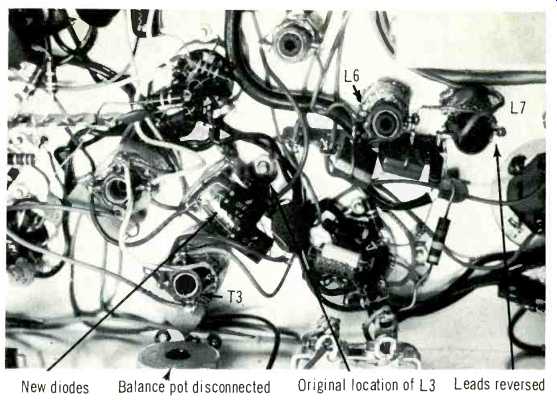
Fig. 1--38-kHz transformers, low-pass filter coils, and modulator diodes.
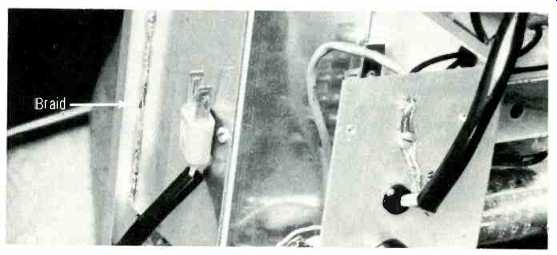
Fig. 2--The effective r.f. shielding.
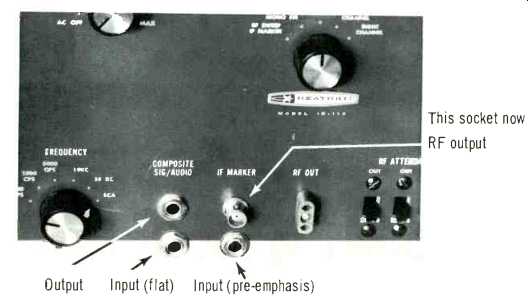
Fig. 3--Stereo generator front panel where the new jacks were added. The
RF OUT socket was disconnected and the r.f. signal was brought out through
the BNC connector labeled "IF MARKER."
The Residual 38kHz Signal
Now the problem of reducing the residual 38-kHz signal was staring at me. In order to Make the decoder under test rely on the 19-kHz signal for sync, the 38-kHz signal had to be down by at least 40 dB. This would also improve the distortion seen in the composite signal. The designed method of obtaining a null balance of the stereo generator could not come close to the requirement. Besides, there was a peculiar distortion in the composite waveshape that could not be straightened out. Once again, it was discovered that the filter coils were picking up radiation, this time from the oscillator coils, T2 and T3! Reversal of the primary and secondary windings of T3 reduced the induced radiation slightly.
The next idea was to try to create balanced and opposing fields around L5 and L6. Finally, relocating the T3 coil provided the desired effect. The location for the maximum null occurred at the screw location for terminal board R. See Fig. 1.
So these two items were swapped. Now the induced 38-kHz was minimized to an acceptable value. See Fig. 8. It is 40 dB below 0.4 volts rms at the Composite/Audio Output jack.
The next item to come under scrutiny was the switching diodes. Since an accurate shape of the composite signal was still not being achieved, the diodes were examined. They were found to have different-forward voltage drops, and it was determined that the 10-k pot, R54, was included for balancing purposes. Also, the filters had to be adjusted to different positions, depending upon what audio frequency was being fed through in order to achieve a maximum amount of separation.
A new circuit was devised, and special matched-pair diodes were purchased. These were the Fairchild FA 2310 E units. The imbalance between the two diodes was guaranteed to be no more than 1 mV. Note the way the diode pairs are wired. See Figs. 4 and 12. This is done so as to bring the audio point as close to ground as possible, and minimize the residual 38-kHz signal without any need for an adjustment. The circuit is so connected that on one half of the cycle, the 38-kHz signal is shorted across the coils. When the diodes conduct, the audio point is effectively grounded. During the opposite half cycle, the diodes do not conduct, and the audio signal passes into the filter. Unlike the previous circuit, this one allowed a clean composite signal to be generated for any frequency between 5 Hz and 15 kHz. See Figs. 5a, 6a, and 7. At last, one setting of the filter coils worked for all audio frequencies!
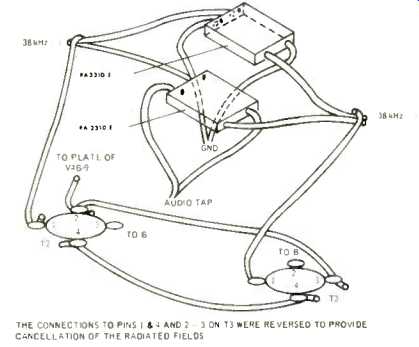
Fig. 4--Showing diode wiring. The connections to pins 1 and 4, 2 and 3 on
T3 were reversed to reduce hum.
The filters were not adjusting properly. The slugs had to be screwed out too far for proper response. Elimination of C23 and C25, and changing C27 from 430 pF to 100 pF resulted in a filter capable of providing the proper shape to the base line of the composite signal. See Fig. 4. It is necessary to adjust the filters so that the base-line deflection is no more than 1/1000 of the other channel signal swing in order to achieve 60 dB of separation. See Figs. 5b, 6b and 7b for the results. Due to circuit irregularities, some compromise must be made on maximum separation at one frequency, vs. equal separation at all frequencies.
To see these results, you need a high quality scope, capable of handling wide signal swings without overloading. The scope must be on d.c. coupling, or the flat base line will sag causing misleading results.
The 19-kHz Signal
The 19-kHz signal was the next item to come under examination. It was distorted. This problem was also partially solved by the reorientation of the oscillator coils. Another improvement in the distortion occurred as a result of putting a 180-k resistor in series with the padder adjustment, C11. The biggest benefit of the series resistor was the reduction of the amplitude of the pilot signal, without having the trimmer almost ready to fall apart. With the pilot level pot all the way up, the trimmer is adjusted for a level of 10 per cent of the full signal swing. (100 percent modulation of full signal swing occurs with 0.86 volts rms being fed into the external audio jack. The output is 0.4 volts rms.) It is important that the pot be in the wide open position when making alignment checks of the separation portion of the stereo decoder. Any other position causes an unknown amount of phase shift which destroys separation. Turning the signal down is valuable only for determining when the decoder will no longer sync with the generator.
To get proper control of the phase for the left and right channels, the 19-kHz phase-shifting networks must be modified. The Phase Test, Right and Left signal 19-kHz phase-shift networks are all referenced to the signal coming from L4. The Phase-Test position provides a 19-kHz signal in phase with the 38-kHz reference point. The generator provides a ±45-deg. phase shift for the left- or right-channel signals. When the decoder doubles the 19-kHz signal to 38-kHz, the phase shift will become ±90 deg. For ease in measuring while aligning the generator, the reference from L4 is used. It becomes imperative that no phase shift through R25 and R26 should occur.
To make the modification, (1) connect a 150-pF capacitor across R26. This balances the capacitance encountered by the wire leading from the switch to the grid of V3-B, (2) Replace R27 with a 5-k pot, and (3) C9 with a 1-nF padder in parallel with a 680-pF capacitor. Connect the scope horizontal to the 19-kHz signal coming into the phase-shift network, and the vertical to the grid of V3-B. The scope will display a straight line on a 45 deg. slope when the value of the 150-pF capacitor is correct. ( Use 10:1 probes, as the probe capacitance of a 1:1 unit is sufficient to give you false readings. The scope must be of sufficient quality to ensure that no phase shift occurs when the vertical and horizontal amplifiers are attenuated in the uncalibrated mode. This condition is easly checked by putting both probes on the same signal. The result will be a straight line if the phase shifts are equal or non-existent. See Fig. 8.) Don't go past here until you are satisfied that the line is straight.
Switch the Mode to the Left channel and adjust the pot for a 45-deg. phase shift. Then switch to the Right channel and adjust the padder for a 45-deg. phase shift in the opposite direction.
For in-phase signals, the cosine of 0 deg. =1.0, and for a 45-deg. phase shift, the cosine of 45 deg.=0.707. Assuming that the scope is adjusted so that the widest part of the loop is 10 units long, and centered about the horizontal axis, the portion of the horizontal axis inside the loop will be 7.07 units long, when the phase shift is 45-deg. Care must be taken to get the pattern centered vertically before taking the horizontal measurement. See Fig. 8.
With the ticklish left-right reference business done, it is now an easy matter to align the phase setting with the 38-kHz oscillator. Modulate the generator with 400 Hz at 0.86 volts. Put the mode switch in Phase Test. Turn the pilot carrier pot all the way up. Check the 10-per cent carrier adjustment and reset if necessary.
Adjust L4 for minimum deflection in the center-line, or base, of the composite signal. See Fig. 8b. A slight compromise will probably have to be made to balance the upper and lower portions of the base line.
In order to prevent any loss of separation in the r.f. section, the modulation control has to be bypassed. The pot has been reconnected as a load resistor. Also, the Deviation-Sweep Width-Audio Level Composite Level, (modulation level) control must be in the wide open position. Any other setting will introduce high-frequency losses that will completely invalidate the stereo separation.
The frequency response of the r.f. modulator was checked out using a Tektronix Wave Analyzer and a chart of Bessel functions. The results demonstrated that the r.f. modulation is flat up to 75 kHz. No changes needed here! This is adequate to transmit a good stereo signal.
What it really means is that the signal you see at the composite audio output you can expect to see at the detector of a high-quality, properly aligned FM tuner.
In order to have equal amplitude signals for stereo left or right or center as compared to mono, the audio attenuator was changed. It was also relocated so that the signal would come from the external audio input jack. The audio attenuator is made up of the 620-ohm and 220-ohm resistors. The sum of these two resistors (840 ohms) works with the 12-k ohm pre-emphasis circuit. If you wish to change the amount of attenuation of the monophonic signal, keep in mind that the sum of the two resistors should be about 840 ohms if you do not wish to change the values in the pre-emphasis circuit also.
In order to test frequency response of tuners and multiplex units, a second audio input jack was added. It is wired in series with the first input jack. When the audio is plugged in here, an RC network is introduced that provides the necessary 75-µsec. pre-emphasis for FM broadcasting. When using this jack, stay with the 0.86-volt input. The output at low frequencies will be down 20 dB from 100 per cent modulation, increasing toward 100 per cent modulation as the audio test frequency is increased. If you increase the low-frequency amplitude to achieve 100 per cent modulation, then the high frequencies will be over-modulated, causing no end of grief for most tuners.
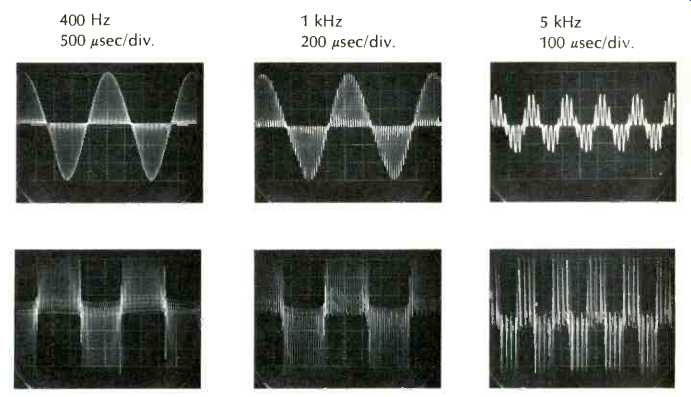
Fig. 5a-vert, 100 mV/div. Fig. 5b-vert, 5 mV/div. (60 dB separation)
Fig. 6a-vert, 200 mV/div. Fig. 6b-vert, 5 mV/div. (54 dB separation)
Fig. 7a-vert, 500 m/V div. Fig. 7b-vert, 5 mV/div. (54 dB separation)
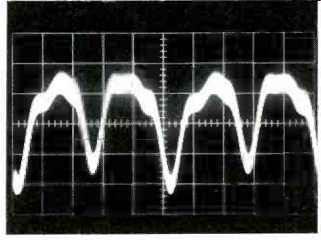
Fig. 8--Residual 38 kHz at the Composite Audio jack when no signal is present.
Vertical scale, 2 mV/div; horizontal, 10 µsec/div.

Fig. 9a shows the correct phrasing of the 19-kHz signal; Fig. 9b is incorrect.
First: check the Phase-test position-the resultant curve should be straight
and at a 45-deg. angle.
With the scope adjusted so that the horizontal portion of the trace is 10 units long and centered vertically, the distance inside the loop along the horizontal centerline is measured. For a 45-deg. phase shift, it should be 7.07 units long. "A" is very close to this value, but the distance in "B" is slightly longer.
To obtain a wider swing in the sweep mode, point F has been removed from the filaments and reconnected to a voltage divider which is connected between one of the power transformer secondary high-voltage leads and ground.
In order to keep local stations suppressed during the tests, the supplied twin lead was scrapped in favor of a 75 ohm coax, hence the BNC jack in the i.f. Marker position. To match the cable to the 300-ohm input of most tuners, a half wave stub can be used. The half-wave stub should be 4 ft. 3 in. long for frequencies around 100 MHz.
The only way that a signal should be able to get into the tuner is via the antenna cable. However, the whole front of the stereo generator was alive with r.f., resulting in totally unpredictable control of the signal strength.
A strong source of r.f. radiation was coming from the tuning knob. An r.f. shorting bar had to be installed over the shaft of the r.f. tuning capacitor. In spite of the original grounding of the shaft, it acted like an antenna. This is because the ball bearings, rolling in grease, do not act as an efficient r.f. conductor.
The shorting bar is just a piece of soft metal from the bottom of a can, with a hole punctured in it. The edges of the hole have been torn back. The bar has been forced over the tuning capacitor shaft. This forces the fingers to press against the shaft and ground it. Holes were drilled in the shorting bar to accommodate the capacitor mounting screws.
While the radiation was reduced, it was by no means gone. It was finally noticed that there was a gap between the r.f. oscillator shield and the front panel.
Filling the crack with wire braid (working it all the way around the three sides of the shield box) eliminated the front panel radiation. See Fig. 2.
To help guarantee that a poor-quality tuner would not pick up any signal from the power line, another filter capacitor was connected from the incoming line to ground. It is connected at the outer lug of the fuse. The capacitor value is 5-nF, 600-volt, mica. The fuse was another of the early modifications, more to protect the shop from fire than the instrument from self destruction. The power cord was also shielded with wire braid and covered with a plastic sheath. It is connected to the chassis with one of the terminal mounting screws located near the power cord entrance.
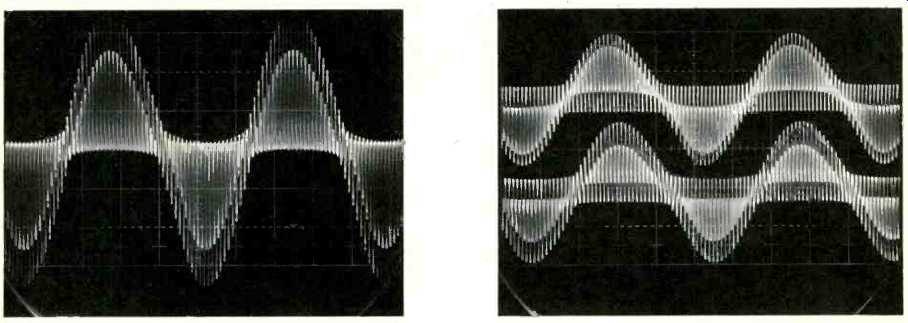
Fig. 10a--Stereo generator output at Composite-Audio jack, 400-Hz signal.
The 19-kHz pilot carrier is set to the required 10% modulation. The lack
of straight base lines shows the degree of 19- and 38-kHz phase inaccuracy.
The phasing adjustment was set for reasonably matched closure of both upper
and lower baselines. Fig 10b clearly shows that each baseline has both a straight
and a curved portion.

Fig. 11--Basic schematic of Heathkit Stereo Generator.
Some attempts were made to obtain reasonable results from the r.f. attenuator switches. Different values of resistance and various grounding combinations were tried, and finally an attempt at shielding the switches from each other and the r.f. generator was made. Unfortunately, the switches are very capacitive with the result that attenuation relies upon phase shift, and not a straight loss as desired. Now these switches are left in the up position and an external r.f. attenuator box is used.
=============
(Audio magazine, Jun. 1970)
Also see:
How To Align Your Stereo Tuner (Part II) (Jul. 1970)
How to evaluate FM stereo tuner performance (Jan. 1972)
"An Integrated Circuit FM Detector" (Feb. 1970)
Men of Hi-Fi--The Perfect FM Tuner (Jan. 1972)
New Specs for the New Tuners (Jan. 1973)
AM Stereo: An FCC Fiasco (July 1982)
FM Fidelity: Is The Promise Lost? (March 1985)
The Problem with FM (March 1985)
= = = =